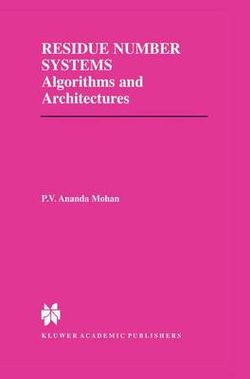There has been continuing interest in the improvement of the speed of Digital Signal processing. The use of Residue Number Systems for the design of DSP systems has been extensively researched in literature. Szabo and Tanaka have popularized this approach through their book published in 1967. Subsequently, Jenkins and Leon have rekindled the interest of researchers in this area in 1978, from which time there have been several efforts to use RNS in practical system implementation. An IEEE Press book has been published in 1986 which was a collection of Papers. It is very interesting to note that in the recent past since 1988, the research activity has received a new thrust with emphasis on VLSI design using non ROM based designs as well as ROM based designs as evidenced by the increased publications in this area. The main advantage in using RNS is that several small word-length Processors are used to perform operations such as addition, multiplication and accumulation, subtraction, thus needing less instruction execution time than that needed in conventional 16 bitl32 bit DSPs. However, the disadvantages of RNS have b. een the difficulty of detection of overflow, sign detection, comparison of two numbers, scaling, and division by arbitrary number, RNS to Binary conversion and Binary to RNS conversion. These operations, unfortunately, are computationally intensive and are time consuming.
- ISBN:
- 9781461353430
- 9781461353430
-
Category:
- Circuits & components
- Format:
- Paperback
- Publication Date:
-
31-10-2012
- Language:
- English
- Publisher:
- Springer-Verlag New York Inc.
- Country of origin:
- United States
- Pages:
- 253
- Dimensions (mm):
- 235x155x15mm
- Weight:
- 0.42kg
This title is in stock with our Australian supplier and should arrive at our Sydney warehouse within 2 - 3 weeks of you placing an order.
Once received into our warehouse we will despatch it to you with a Shipping Notification which includes online tracking.
Please check the estimated delivery times below for your region, for after your order is despatched from our warehouse:
ACT Metro: 2 working days
NSW Metro: 2 working days
NSW Rural: 2-3 working days
NSW Remote: 2-5 working days
NT Metro: 3-6 working days
NT Remote: 4-10 working days
QLD Metro: 2-4 working days
QLD Rural: 2-5 working days
QLD Remote: 2-7 working days
SA Metro: 2-5 working days
SA Rural: 3-6 working days
SA Remote: 3-7 working days
TAS Metro: 3-6 working days
TAS Rural: 3-6 working days
VIC Metro: 2-3 working days
VIC Rural: 2-4 working days
VIC Remote: 2-5 working days
WA Metro: 3-6 working days
WA Rural: 4-8 working days
WA Remote: 4-12 working days





Share This Book: